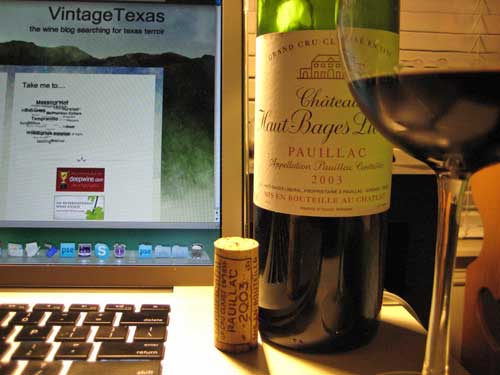
Guilty As Charged. Texas WineSlinger Admits, “I Drink Foreign Wine”
Yep! That’s right, I said it. It is a full admission. But, why?
You would be amazed at some of the emails that I receive. Some contend that I am one-dimensional. This statement, I guess, is in reference to the fact that I created this blog that focuses on wines from one region. I agree that VintageTexas does focus on my experiences with Texas wine and my travels around the state. However, do I only drink Texas wine? The answer is a resounding, no!
After all, I do taste a lot of Texas wine. It is also likely true that I taste or drink more Texas wine than probably ninety-nine point nine percent of the people in the state. However, when and wherever possible, I try to drink non-Texas wine. The purpose, after the enjoyment of it, is frankly to keep my palate in calibration.
Have you ever heard the stories of winemakers that develop “cellar palate”. That’s when a winemaker tastes so much wine from his or her own winery and starts to overlook the flaws in the wines. The palate is a funny thing. It can be numbed to death particularly by off-putting tastes and odors, particularly the dank, dirty, sulfurous overtones that are ever-lurking in the depths of a winery’s cellar; in tanks, barrels and the maze of hoses. Cellar palate can happen to winemakers especially, when testing and retesting their wines as they go from tank to to tank to barrel to another barrel to bottle.
The lesson here is to try many different types of wines and from many wineries and many wine regions around the world. I know Texas wine and I know good Texas wine from bad, but I don’t just stick to what I know. Even more importantly, I feel that it is critical to drink wine from acknowledged premium producers on a regular basis. This way, I keep my palate sharp, and as a knowledgeable consumer of Texas wine you should too. You should be demanding a world-class product from your Texas wineries. The only way you can do this is to have a calibrated palate that knows what quality tastes like.
Case in point, we are getting many new varietal wines and blends made in Texas. Wine growers in Texas are finally starting to explore what I refer to as our “Texas Terroir” and are growing varieties of grapes that grow best in Texas. Admittedly, there can be some really good Cabernet, Merlot and Chardonnay made in Texas, but unfortunately, its hard work to get them to the peak of excellence and even harder to do it year in and year out, and do it in an economically sustainable manner.
As you read in my previous blog (https://vintagetexas.com/?p=1857) and my New Texas Wine Lexicon blog (https://vintagetexas.com/?p=1621), you will have to admit that Viognier, Roussanne, Vermentino, Muscat, Tempranillo, Barbera, Mourvedre and Sangiovese are just a few of the weird sounding grape varieties doing very well here. They are easier to grow and ripen to the peak of excellence in our hot summer sun and they have some additional tolerance to the late spring killer freeze that is probably the biggest barrier to sustainability of our local wine industry.
However, it’s one thing to be able to grow a particular grape here in Texas and another to be able to make it into a really fine wine. That’s why I find that it’s important to know the real deal. What does a Rhone blend tastes like and particularly what it tastes like when made by winemakers of merit that can bring out maximum quality and character? It’s also important to know the native regions from which these new Texas grapes are derived. This knowledge can be obtained through reading and discussion with people that have been there and done that. These people can be friends, family, a local wine shop owner, wine writers, or even a lowly blogger. I sometimes get the feeling that I am a messenger; a mere avatar for my readers to experience some of these things through me [By the way, this is a role that I readily accept, and I am always willing to response to reader comments and questions.] However, the best way to gain these insights is to travel to the motherland of these new varietals, try the wines, tromp through the vineyards and talk to the people that make and consume these wines over there.
If you follow my logic, you can see why I readily admit to drinking foreign wines and try as much as possible to go to the source to experience the best incantation of a wine. It is Napa for Cabernet, Bandol for Mourvedre, Barolo for Nebbiolo, Spain for Tempranillo, France and Argentina for Malbec, Australia for Shiraz, and South America for my first taste of Tannat.
There…I have gotten it off of by chest. I am a Texas wine aficionado and I’ll grant you that. But, I am no shill for Texas wine and demand a quality wine product from Texas. I do this by drinking foreign wine and I drink it often. You know what….and I’m a better person (and wine professional) for it.
I hope that you too will drink and support Texas wines, but drink foreign wines when you can to keep your palate calibrated. It will also help you to understand where we are going as a wine-producing region and only then will we all be better wine tasters and consumers.


Hey Russ I totally agree with you…. unfortunately I have found that some Texas wineries have “cellar palate” There are a few places where I have been that they tell me how great their wine is then I taste it and it takes allot for me to keep a straight face and say something nice.
Honestly I think that many Texas Wine enthusiast need to taste a few more Tempranillos and Viogniers from Europe.
However, the Chenin Blancs from Texas are the best kept secret in the country!